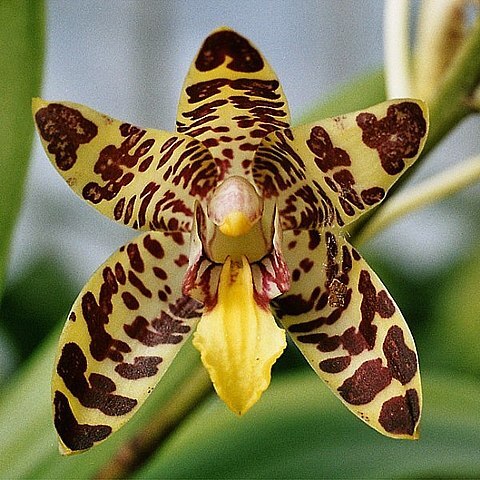An erect very variable epiphytic plant 50–125 cm. tall.. Pseudobulbs fusiform or cylindric, slender, slightly tapering above, 10–50 cm. long, ± covered by papery sheaths and leaf bases when young.. Leaves 8–10, in apical half of pseudobulb, narrowly lanceolate, acute or rarely obtuse, 15–50 cm. long, 1.4–5(–6.5) cm. broad.. Inflorescences laxly 30–40-flowered, much branched; bracts ovate, acute, 1–5 mm. long.. Flowers yellow, ± heavily blotched with dark maroon.. Dorsal sepal elliptic, obtuse, 1.6–3.3 cm. long, 0.5–1 cm. broad; lateral sepals similar but slightly longer.. Petals elliptic, rounded at apex, slightly shorter and broader than sepals, 1.6–2.8 cm. long, 0.5–1.1 cm. broad.. Lip 3-lobed, 1.4–2.2 cm. long, 1.2–1.9 cm. broad, bearing 2–3 longitudinal keels in centre; side lobes erect, rounded in front; mid-lobe orbicular to obovate, retuse or obtuse with undulate margins.. Column up to 1.2 cm. long.. Fig. 88.
Erect epiphyte, up to 1.25 m high. Pseudobulbs fusiform, long, many-leaved. Lip lacking a spur. Sepals and petals similar. Petals elliptic, rounded at apex. Flowers yellow, ± heavily blotched with dark maroon.
Lip 14–22 × 12–19 mm, 3-lobed, with 2–3 longitudinal keels down the centre; side lobes erect, rounded in front; mid-lobe orbicular to obovate, obtuse and apiculate or retuse, the margins undulate.
Pseudobulbs clustered, 10–60 cm long, 1–3 cm wide, fusiform or cylindrical, ribbed with several nodes, yellow or yellow-green.
Flowers usually yellow, blotched lightly or heavily with red-brown, but occasionally plain yellow or yellow-green.
Leaves 4–10, borne on apical half of pseudobulb, 15–50 × 1.5–5 cm, lanceolate, acute (rarely obtuse), dark green.
Inflorescence apparently terminal but arising from a node just below the apex, paniculate, laxly many-flowered.
Petals 16–30 × 5–14 mm, elliptic, rounded at the apex, slightly shorter and broader than the sepals.
Dorsal sepal 16–35 × 5–10 mm, elliptic, obtuse; lateral sepals similar but slightly longer.
Robust epiphytic herb, sometimes lithophytic, 50–125 cm tall.
Flowers yellow with red or purple spots
A robust epiphyte, up to 3-5 ft. high
Pedicel and ovary 2.5–4 cm long.
Column to 12 mm long.
Bracts 1–5 mm long.


